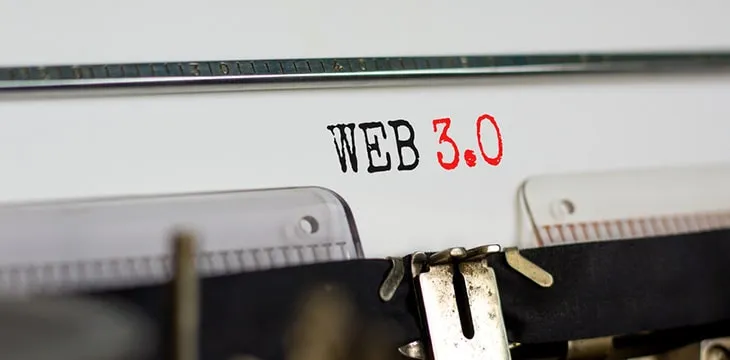|
Getting your Trinity Audio player ready...
|
If you’re involved in the digital currency and blockchain industries, you’ve almost certainly heard of Web 3.0. It’s the latest buzzword in the blockchain sector, and it seems to be dominating the thoughts of some of the world’s best-known tech leaders.
While doubtless an exciting concept with lots of potential to disrupt the status quo, what exactly is Web 3.0, and what will it take to be successful? We’ll explore these concepts and questions here.
Web 3.0: More than just a marketing buzzword
There’s indeed a lot of hype and exaggeration about Web 3.0, causing high-profile individuals like Jack Dorsey to dismiss it. However, Web 3.0 is a real thing, a true evolution of the internet and how it works.
What will Web 3.0 involve? A few different things, but in its essence, it will mean peer-to-peer transactions, the elimination of trusted third parties, and micropayments replacing ad-based and data harvesting revenue models. Web 3.0 isn’t one thing but is a combination of things evolving at the same time to change the way the internet works forever.
Hope and concern about the new web
As you might expect, Web 3.0 has its evangelists and skeptics, just like the internet did.
On the one hand, there are bullish optimists who promise a new, decentralized internet with greater user control, privacy, and freedom. On the other hand, there are cautious Jeremiahs who warn of the unchecked proliferation of illegal or harmful content and a new tech oligarchy forming to control Web 3.0 from the shadows.
The truth is that Web 3.0 has benefits and drawbacks like everything, and there always exists the promise of a better world and a whole new set of unforeseen problems. The evolution of the current internet illustrates this point perfectly. It held so much promise and has changed the world in many positive ways, but it came with many unexpected problems that are now coming to a boiling point.
Two visions of Web 3.0—and the one that will win out
While Web 3.0’s critics are right to point out some of the dangers it poses, their main concerns are founded on a misunderstanding about blockchain technology and digital currencies. Outright lies have been promoted about how Bitcoin and blockchain technology work, so it’s not surprising that many are ill-informed about the world Web 3.0 will lead to.
For example, take the myths promoted by proponents of digital currencies like BTC, ETH, Monero, and their associated blockchains. According to the acolytes of these systems, Web 3.0 should be ‘decentralized’ in such a way that governments and laws will be rendered powerless. The ‘Code is Law’ mantra is promoted by many of these types who see a world of uninhibited trade in contraband, anonymous transactions, lending and borrowing money without KYC/AML checks and regulations (DeFi), and the ability for so-called smart contracts to render human laws null and void.
Much of the concern about these ideas is unnecessary. None of them will ever become a reality because the blockchain systems they are built around are not technically capable of delivering their visions at scale. The quest for so-called decentralization comes at a cost; none of these systems have been able to handle even a fraction of the transactions that Web 3.0 will generate.
What the real Web 3.0 will look like
By contrast, blockchains that do scale, such as BSV enterprise blockchain, are capable of delivering Web 3.0 but will offer a very different version of it. This version will be powered by micropayments, users will experience an unprecedented level of freedom where they will own their own data, and this will all be delivered in such a way that all existing laws and regulations will be both respected and strengthened.
How is this possible? On a scalable system like Bitcoin SV, all transactions occur on the blockchain rather than jumping through layer-2 solutions like the Lightning Network, and all transactions are time-stamped on the public ledger and signed with a digital signature. They leave an immutable evidence trail, allowing for tracing if illegal activity occurs while protecting user privacy in all other cases.
All of this will lead to a much safer, sane version of the web, opening up opportunities to trade worldwide and engage in all manner of small, casual transactions. All promises of greater user control and the elimination of trusted third parties will remain, but users will be better protected. For example, on this version of Web 3.0, it will be possible to recover stolen funds easily. Important Web 3.0 ideas like DeFi can become a reality, but instead of hooded anons lending each other digital tokens at extortionate rates, wallets will be linked to identity so that lenders and borrowers are protected, and financial laws can be applied in the appropriate jurisdictions.
This solid, legally compliant foundation upon which Web 3.0 will be built can lead to a new era of increased economic efficiency, expanded opportunities for commerce, particularly with regards to microtransactions, and a period of unprecedented transparency.
This second version of Web 3.0 has the best chance of becoming a reality. To learn more about it and the technology that underpins it, join the BSV Global Blockchain Convention in Dubai or online on May 24-26.

 07-03-2025
07-03-2025 





